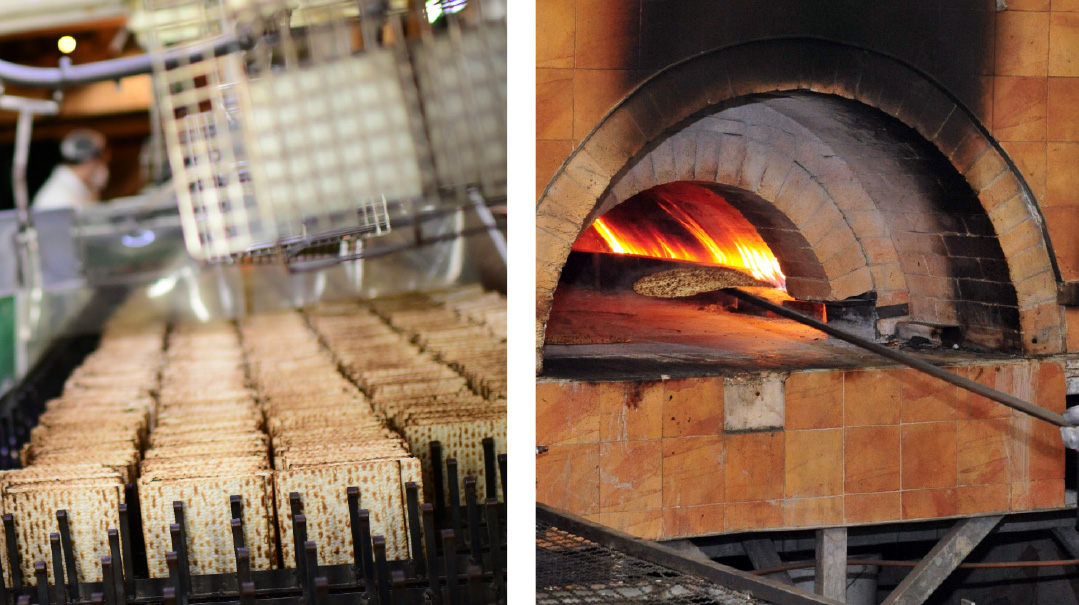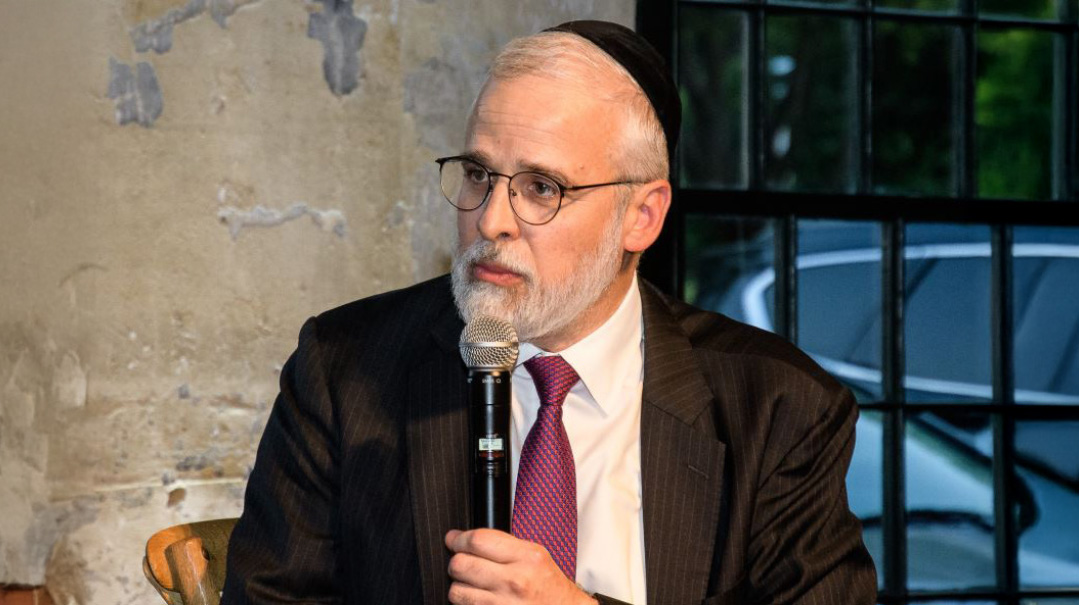Squaring the Circle: Do You Eat Machine Matzah?
| March 25, 2025There is hardly another topic in halachic literature of the last centuries for which so much ink has been spilled

PHOTO: FLASH90/ CHAMELEONSEYE
AT the hand matzah factory in Moshav Komemiyus in southern Israel, the air is thick with flour... and urgency. Workers move in swift, practiced motions — rolling, perforating, and transferring dough to the oven in a carefully choreographed rhythm. Every second counts, with supervisors ensuring the process is completed well before the 18-minute limit. The crackle of the flames, the sincere kavanah, and the sweat of human effort create an atmosphere of devotion and discipline. Tradition is felt in every touch.
Not far from this world of human effort and heat lies a different kind of precision. In the Yehuda Matzos automated factory in Jerusalem’s Givat Shaul, the rhythm is mechanical rather than human. Stainless steel machines hum steadily, rolling and cutting the dough with exacting consistency. Conveyor belts glide smoothly, feeding uniform sheets into high-temperature ovens. Here, halachic supervisors can be assured that the process is completed in no time; everything happens at the push of a button. The Manischewitz matzah bakery, a similar operation across the ocean in America, reports producing about 76 million matzos annually.
Today, machine matzah is firmly established in Jewish tradition, and probably the majority of Jews eat it on Pesach. But this was not always the case. There is hardly another topic in halachic literature of the last centuries for which so much ink has been spilled — one whose impact even carried political consequences. From the very beginning, machine matzah was shrouded in controversy, and the debate that erupted among 19th-century poskim and manhigim divided the Jewish world.
The industrialization of the 19th century inspired Jewish inventors to explore ways to simplify religious life. In 1838, in Ribeauvillé, France, Jewish mechanic Isaac Singer invented the first matzah machine, and news of it spread quickly across France and Germany.
To understand the significance of this invention and the enthusiasm it generated, it is necessary to consider the challenges of traditional matzah production.
Halachah requires that no more than 18 minutes pass from the moment flour is mixed with water until the baked matzah comes out of the oven — otherwise, the dough becomes chometz and is forbidden on Pesach. This means that mixing, cutting, rolling, and baking — all performed manually — must be completed within a very short time, in stifling heat. Before the invention of the matzah machine, matzah production was time-consuming and expensive.
With the modernization of this process, production could be drastically simplified and accelerated. A machine could handle the labor-intensive steps at the push of a button, reducing the need for manual work and lowering costs. This made matzah more affordable for the poor, who often relied on kimcha d‘Pischa to obtain it. It is no surprise that by 1845, a matzah machine was in operation in Frankfurt am Main, and by 1852, the first matzah factory was established in Poznań, Poland. Seven years later, news of the machine reached Galicia — and with it, the ears of local rabbanim.
Those Opposed
The controversy began in earnest in 1859. The first posek to prohibit “machine matzah” was Rav Shlomo Kluger (1785–1869), the rav of Brod and author of Chochmas Shlomo, one of the most prominent halachic authorities of the 19th century. He was soon joined by the Divrei Chaim of Sanz, Rav Chaim Halberstam (1793–1876), who viewed it as chometz gamur; and by the Chiddushei HaRim of Gur, Rav Yitzchak Meir Alter (1783–1866).
He wrote: “Regarding their question about machine-made matzos for Pesach... I agree to forbid it. May Hashem save His people from those people who are agents of the yetzer hara, talmidim of Yeravam Ben Nevat.... May Hashem thwart their plans, and may Hashem’s counsel prevail.”
That same year, they published Modaah l’Beis Yisrael (“A Warning to the House of Israel”), a compilation of their arguments against machine-made matzah.
The arguments in Modaah l’Beis Yisrael covered a range of concerns, spanning halachic and hashkafic issues and broader social implications. One of their strongest objections was that machine matzah had its origins in France, a stronghold of Reform influence. They feared that its introduction was not merely a technological advancement but part of a broader effort to weaken the mesorah.
Beyond ideological concerns, they also pointed to the potential halachic risks. Unlike hand matzah, where every batch is carefully monitored, machine production left room for chometz to form. Residual dough could stick to the machinery and remain there for longer than the permitted 18 minutes, creating a real risk of chometz.
Another major argument centered on the kavanah of preparing matzos mitzvah — the matzah used to fulfill the mitzvah on Seder night. According to halachah (Shulchan Aruch, Orach Chayim, siman 460), the matzah must be made l’sheim mitzvah. How could a machine, operating automatically at the push of a button, be considered l’sheim mitzvah?
Finally, there was the question of livelihood. Hand matzah production had long been a source of income for many Jewish laborers, and the rapid spread of machine-made matzah threatened to put these traditional bakeries out of business.
In the Defense
Despite all these well-founded challenges, many prominent rabbanim defended machine-made matzah — and even preferred it over hand matzah.
The first and strongest advocate was Rav Yosef Shaul Nathansohn (1810–1875), the rav of Lemberg and a prolific halachic author. Other supporters included Rav Avraham Shmuel Sofer (1815–1871), the Ksav Sofer of Pressburg; Rav Yaakov Ettlinger (1798–1871), author of Aruch Laner; Rav Yisrael Lipschitz (1782–1860), known for his Tiferes Yisrael commentary on the Mishnah; and the Würzburger Rav, Rav Yitzchak Dov Bamberger (1807–1878).
In response to Modaah l’Beis Yisrael, Rav Nathansohn published Bitul Modaah (“Annulment of the Warning”), refuting the arguments against machine-made matzah.
Regarding the concern that residual dough might stick to the machines and turn into chometz, supporters argued that the machines are thoroughly cleaned and inspected between each batch, ensuring that no leftover dough remained. Today, in many machine matzah factories, the parts of the machines that come into contact with dough are covered with plastic or paper, which is replaced between batches, in addition to the regular cleaning and inspection.
The question of whether machine-made matzah fulfills the l’sheim mitzvah requirement touches on a fundamental halachic issue: To what extent must a person, with the specific kavanah (l’sheim mitzvah), be directly involved in every step of the process? Or is pressing a button to start the process sufficient?
The gemara, in Chullin 17a, discusses a case in which someone performed shechitah using a knife attached to a waterwheel. It distinguishes between the first turn, which was actively initiated by a person (koach rishon) — making it a valid shechitah — and subsequent turns, which were merely a continuation of the first action (koach sheini), and therefore not permissible.
Some poskim cited this as proof that a process that continues automatically after being started by a human is no longer considered his direct action. If l’sheim mitzvah is required, such a process would therefore be invalid.
Rav Aryeh Zvi Frommer, the Kozhiglover Gaon and rosh yeshivah of Yeshivas Chachmei Lublin, discusses in Shu”t Eretz Tzvi (siman 5) whether tzitzis may be produced using an electric machine. He refutes the proof from the waterwheel case, arguing that in that instance, the person merely removed a barrier that was stopping the water from flowing, without performing an action directly related to the water itself. Therefore, the subsequent movement (koach sheini) was not considered his own action. However, in a case where a person performs a direct action, even an indirect result (koach sheini) is still considered human activity.
Although he was discussing the production of tzitzis, the same logic would apply to machine-made matzah, as tzitzis also require l’sheim mitzvah.
The Conversation Continues
The debate did not end with the first generation of rabbanim. Although the debate was at first purely halachic and hashkafic, over time it sadly took on a political dimension.
Because the majority of rabbanim opposed to machine matzah were chassidic rebbes (such as Rav Avraham Bornstein, the Avnei Nezer; Rav Yechezkel Shraga Halberstam, eldest son of the Divrei Chaim; and others), while its supporters were mostly non-chassidic Torah authorities from Western Europe and Lithuania, the controversy slowly transformed into a broader conflict between chassidim and misnagdim. It should be noted that this division was driven not by the rabbanim themselves but by secular Jewish journalists, particularly those writing for the Hebrew newspaper HaMagid, who sensationalized the dispute and “poured oil on the fire.”
However there were exceptions on both sides. The Maharsham of Brazin (Rav Shalom Mordechai HaKohein Shwadron), for example, allowed machine matzah, despite being a Galician chassid. And Rav Meir Auerbach (1815–1878), the Imrei Binah, who later became the first Ashkenazi chief rabbi of Jerusalem, joined the ranks of those fighting against machine matzah.
Over time, matzah machines and factories have been repeatedly modernized to eliminate chometz concerns. As a result, even chassidic poskim today acknowledge that modern machine matzah is not chometz. However, many chassidic dynasties have remained faithful to their mesorah of eating exclusively hand matzah.
The majority of Ashkenazim, in both Israel and the Diaspora, use machine matzah as well. Some have the custom of eating hand matzah only at the Seder while relying on machine matzah for the rest of Pesach — ensuring that on the night of the 15th of Nissan, they fulfill the mitzvah according to all opinions.
And so, from the flour-dusted hands in the Komemiyus bakery to the gleaming machines in Givat Shaul, the evolution of matzah production reflects a broader tension within Jewish tradition — the balance between preserving the mesorah and embracing technological progress. It is a conversation that continues to this day, as gedolim in every generation grapple with the intersection of innovation and halachah.
Rabbi Dovid Gernetz is a musmach of Rabbi Yitzchak Berkovits and is currently a maggid shiur at the Rabbinerseminar and the assistant rabbi of Kahal Adass Yisroel, both in Berlin.
(Originally featured in Mishpacha, Issue 1055)
Oops! We could not locate your form.







